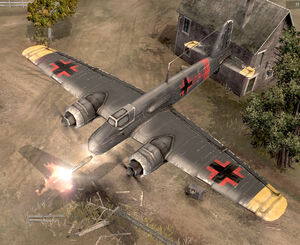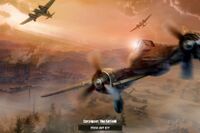| Henschel Hs 129 "Panzerknacker" | |
|---|---|
 A Henschel Hs 129 on an attack run | |
| Army | Panzer Elite |
| Role | Anti-Vehicle Attack Aircraft |
| Unit Cost | Special |
| Upkeep per Minute |
|
| Prereq. | Luftwaffe Tactics: Henschel Combat Air Patrol |
| Produced By | None; called in from the field. |
| Primary armament | 7.5 cm PaK 40 Automatic Cannon |
| Health |
|
| Armor | None |
| Max. Speed | ~40 m/s |
The Henschel Hs 129 "Panzerknacker" is a ground-attack aircraft supporting the Panzer Elite Luftwaffe Tactics company, in Company of Heroes: Opposing Fronts. It is armed with an automatic rapid-firing PaK 40 cannon. Several of these powerful aircraft can provide anti-tank firepower through the use of the Henschel PanzerKnacker Support Command Ability, where they will strafe a given position to destroy any enemy vehicles found within it.
Note: The Henschel is not a field unit. It is not selectable, and cannot be given specific orders. It does however interact with the environment, and can be shot down by enemy anti-aircraft units.
Overview[]
At the very end of the Luftwaffe Tactics Command Tree, the Panzer Elite player can finally receive actual air support from the German air-force, in the form of Henschel Hs 129 ground-attack aircraft.
The Henschel is a heavy, two-engined attack aircraft. It carries one of the largest weapons ever installed on an aircraft in the history of aviation: a 7.5 cm PaK 40 anti-tank cannon, the same weapon normally installed on a Marder III Tank Hunter. This weapon has been modified for automatic fire, enabling it to rapidly bombard any target the Henschel's nose happens to be pointed at. Since it is essentially a tank-destroyer cannon, the PaK 40 can cause massive damage to anything it hits.
To receive support from these aerial monsters, the player must first acquire the Henschel Combat Air Patrol upgrade from the Luftwaffe Tactics Command Tree. This unlocks the Henschel PanzerKnacker Support Command Ability. Each use of this ability costs ![]() 200.
200.
When the ability is activated, a target zone 30-meters in radius is selected. The entire zone becomes visible (Fog-of-War is cleared), and for the next 45 second it will be targeted by passing Henschel Hs 129 attack aircraft. As long as at least one enemy vehicle is inside the targeted zone, Henschel aircraft will swoop in, at 10-second intervals, and strafe the entire area with their impressive cannons.
The Henschels themselves are not actual field units like other vehicles. They cannot be selected, cannot be issued orders, and of course do not consume any Population Cap points. They will simply strafe the designated area until it is clear of targets, and once the ability timer runs out they will fly off and not return until the ability is used again.
However, like any other aircraft, while they are flying overhead the Henschels are vulnerable to enemy anti-aircraft fire. The allies possess two units capable of this: the Bofors 40mm Cannon and a quad-mount-upgraded M3 Halftrack. Either unit can shoot down Henschels with some accuracy, so their presence can put an attack run in serious jeopardy.
Weapons[]
The Henschel Hs 129 was one of a few two-engined aircraft in the Second World War to mount a large calibre anti-tank gun (most notably the de Havilland Mosquito, the North American B-25 Mitchell and the Junkers Ju 88). However the 7.5 cm PaK 40 Bordkanone, with its large auto-loader and semi-automatic firing mechanism, was significantly larger than its allied counterparts - not to mention much more effective, being larger in calibre than the British Molins 6-pounder and not hand loaded like the American 75mm M4 Cannon.
The Hs 129 and Ju 88 would hold the record for largest aircraft mounted autocannon with the PaK 40 Bordkanone until 1972, with the advent of the A-10 Thunderbolt II and its fearsome GAU-8 Avenger 30mm Rotary Cannon.
7.5 cm PaK 40 Bordkanone[]
Note: To simulate the rapid-firing capabilities of the weapon, the game actually "pretends" that this vehicle has two PaK 40 Brodkanones installed - a "dumbfire" version and a "smart targeting" version. They fire almost in unison, giving the appearance of a single weapon firing many shells rapidly. There are very slight differences between these two weapons.
This is a heavy anti-tank cannon, with an automatic fire capability. It is essentially the same weapon installed on a Marder III Tank Hunter, with the addition of a self-loading mechanism that allows it to fire very rapidly.
Each shell fired by the cannon inflicts 200 points of damage. This is a very high damage output, surpassing most anti-tank cannons in the game. In addition, the shell has a blast radius of 2.5 meters, which can inflict down to 40 points of damage to units further away from the blast point.
During a pass, the Henschel will fire only 10-12 shells, at intervals of about 1 second between each shell. Half of these shells are fired from the "dumb" version of the weapon, which will simply target the ground along the flightpath. The remaining shells are fired from the other, "smart" weapon, which attempts to adjust and fire specifically at enemy targets if it can. It can swivel up to 10 degrees off the flightpath as necessary.
Owing to the superior firepower contained in this weapon, coupled with the high velocity it receives from the movement of the aircraft itself, the Penetration value of the shells is incredible. It has a 60% chance of penetrating the front armor on the heaviest Allied vehicle, the M26 Pershing, and well over 100% chance to penetrate any other armor (including the Pershing's rear armor).
Note that the Henschel's strike can easily cause a lot of damage to enemy base structures - they will suffer 100 points per hit. Enemy Defensive Structures receive the full 200 points per hit.
Tactics[]
Henschel strikes are a fantastic way to get rid of an entire enemy armored force all at once. By targeting the right area at the right time, you can cause the quick annihilation of many enemy vehicles, possibly even structures and infantry.
To utilize this strike correctly, you must note several things about how it works:
- Henschels will only swoop in on the target area when it contains at least one enemy vehicle. If at any time the area only contains infantry or buildings (or nothing at all), no Henschel will attack it.
- Henschels fly low and fire directly forward. As a result, a target standing in a large courtyard surrounded by buildings cannot be hit, since shells will impact the buildings instead. There's always some chance that the Henschel will fly in at the correct direction to fire through gaps between the buildings, but don't count on it.
- Henschels will basically leave a path of destruction as they fly by. As a result, attacks on enemy vehicles in your own territory can endanger your own units and/or buildings. Of course it also means that attacks inside enemy territory can cause collateral damage to enemy assets - especially when performed close to his base.
When taking all of these factors into account, we can draw up some basic offensive and defensive strategies for using this weapon.
Offensive Strikes[]
To perform a good offensive strike, use Camouflaged Kettenkrads to scout your enemy's defensive positions, looking particularly for enemy vehicles among several Defensive Structures, or a large number of enemy units (again including at least one vehicle) rallying for an assault.
Try avoiding strikes on urban areas: your shells are more likely to hit the ambient buildings than they are to hit any units. If you can catch the enemy in an open field, he will lose many units to your airstrike.
The more concentrated your targets are, the better. However, do not hesitate to attack a sparser group.
If you possibly can, try to get a Kettenkrad to scout out the enemy base. If there is at least one vehicle in the base vicinity, an attack on that area can easily cause massive damage to the enemy's structures, potentially destroying one or more of them. Just hope that the enemy does not drive his vehicles out of the area, as that will simply cause the airstrike to end.
Remember that the Henschel support strike reveals a 30-meter-wide area of the Fog-of-War surrounding your target. Make sure to use this time to study the layout of the target area as an additional bonus.
Defensive Strikes[]
When the enemy lashes out with an armored column or large group of vehicles, you can perform a Henschel strike on your own territory to stop and/or disperse them.
For best effect, engage the enemy force first. While they are battling your forces, the enemy units are largely stationary and cannot advance or retreat out of the targeted strike area easily, making them perfect targets.
Note however that during such strikes you are exposing your own units to collateral damage. Do not attempt this in close proximity to your own Defensive Structures, as these might be destroyed in the strike by mistake. For the same reason, you should not call in a Henschel strike on your own base except as a last resort (i.e. when about to be overwhelmed anyway).
Finally, if you can possibly do so, try to draw the enemy out of any urban areas before initiating the strike. Retreat your units tactically to try and convince the enemy to chase you, then hit them with the Henschels once they are out in the open.
Weaknesses[]
As a non-field-unit, there is little you can do to protect a Henschel from damage. Fortunately, only one unit from each of the Allied factions can do anything against your aircraft - the British Bofors 40mm Cannon, and the American M3 Halftrack with a Maxson Quad Mount installed. The Halftrack is less dangerous, and can rarely shoot down a Henschel at all. The Bofors, however, is a little more dangerous. Two Bofors was sufficient to destroy Henschel before it can come into an attack range.
If you possibly can, try to destroy these units before sending in a strike anywhere on the map.
Gallery[]
| Panzer Elite Arsenal | |||||||||||
|---|---|---|---|---|---|---|---|---|---|---|---|
| Base Structures | |||||||||||
| Infantry Squads | |||||||||||
| Light Vehicles | |||||||||||
| Medium Vehicles | |||||||||||
| Heavy Vehicles | |||||||||||
| Defensive Structures | |||||||||||
| Other Structures | |||||||||||
| Tactics | |||||||||||
| Tactics-specific Units |
| ||||||||||
| Tactics-specific Structures |
| ||||||||||



